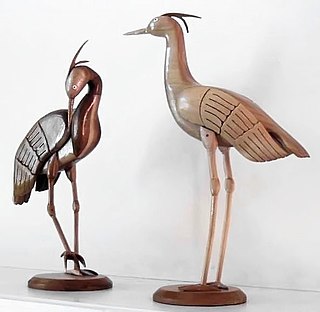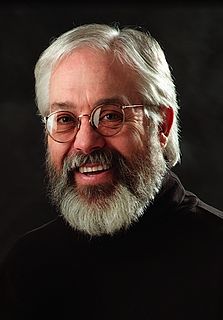
Woodworking is the skill of making items from wood, and includes cabinet making, wood carving, joinery, carpentry, and woodturning.
Jeremy Broun is a British furniture designer maker, writer, film maker and musician.
Tage Frid was a Danish-born woodworker, educator and author who influenced the development of the studio furniture movement in the United States. His design work was often in the Danish-modern style, best known for his three legged stool and his publications.

Sam Maloof was a furniture designer and woodworker. Maloof's work is in the collections of several major American museums, including the Metropolitan Museum of Art, the Los Angeles County Museum of Art, the Philadelphia Museum of Art, and the Smithsonian American Art Museum. Maloof, the first craftsman to receive a MacArthur fellowship, was described by The New York Times as "a central figure in the postwar American crafts movement".

Michael Thonet was a German-Austrian cabinet maker, known for the invention of bentwood furniture.

A workbench is a specialized table used by woodworkers. Among its key features are a flat, solid work surface and one or more means of holding work while being tooled.
Mark Lindquist is an American sculptor in wood, artist, author, and photographer. Lindquist is a major figure in the redirection and resurgence of woodturning in the United States beginning in the early 1970s. His communication of his ideas through teaching, writing, and exhibiting, has resulted in many of his pioneering aesthetics and techniques becoming common practice. In the exhibition catalog for a 1995 retrospective of Lindquist's works at the Renwick Gallery of the Smithsonian American Art Museum, his contributions to woodturning and wood sculpture are described as "so profound and far-reaching that they have reconstituted the field". He has often been credited with being the first turner to synthesize the disparate and diverse influences of the craft field with that of the fine arts world.
Evert Sodergren was a leading studio furniture maker based in Seattle. He taught for many years in the School of Art at the University of Washington.

Steam bending is a woodworking technique where wood is exposed to steam to make it pliable. Heat and moisture from steam can soften wood fibres enough so they can be bent and stretched, and when cooled down they will hold their new shape.
Stewart Wurtz is a studio furniture maker based in Seattle. He has exhibited locally in the Pacific Northwest and nationally at a variety of galleries and museums.

Sal Maccarone is an American author, sculptor, designer and kinetic artist. He is best known as a master craftsman, and for his internationally distributed woodworking books such as Tune Up Your Tools, and How to Make $40,000 a Year Woodworking, both published by F & W publications, Betterway Books, in Cincinnati, Ohio. He is also known for his woodworking technique articles published both online since 1994, Article. and by the national magazine Popular Woodworking. Article. Articles such as his "Evolution of an Entryway" have also been published in industry specific journals.
Matthew Burt is a furniture designer-maker in England who runs a contemporary practice from a studio and workshop based in the South Wiltshire village of Sherrington, west of Salisbury. His work has been displayed in significant public exhibitions, most notably in the OneTree touring show and at the House of Commons in 2008 in a selection of work intended to raise the profile of UK furniture making to members of parliament. His solo museum exhibition Idea to Object was held at the Crafts Study Centre, Farnham in 2008.Matthew Burt's workshop steadily built on a reputation for furniture design that allies structurally robust work that fulfils its function with a lean, elegant line and the occasional bravura surface. Burt has said that he regards the 'intermingling of science, engineering, mathematics, aesthetics and metaphorics' as the fundamental building blocks for his furniture.
Arthur Espenet Carpenter was a master woodworker and furniture maker in Bolinas, California known for his wishbone chair and desk with scalloped seashell sides. Self-taught, he joined the Baulines Craft Guild. He also taught had apprentices. His work is in the collection of the Smithsonian Institution and has been exhibited in The Museum of Modern Art and The Museum of Arts and Design in New York. He was declared a “living California treasure” in 1984. He received The Furniture Society's Award of Distinction in 2001.

Furniture created in the Art Nouveau style was prominent from the beginning of the 1890s to the beginning of the First World War in 1914. It characteristically used forms based on nature, such as vines, flowers and water lilies, and featured curving and undulating lines, sometimes known as the whiplash line, both in the form and the decoration. Other common characteristics were asymmetry and polychromy, achieved by inlaying different colored woods.

Norm Sartorius is an American woodworker who carves fine art spoons in many styles including natural, biomorphic, abstract, symbolic, ethnic, and ceremonial. His works are in the permanent collections of the Smithsonian American Art Museum's Renwick Gallery, the Yale University Art Gallery, the Philadelphia Museum of Art, and other public and private collections. He is a frequent participant in woodworking and craft shows in America, and won the Award of Excellence in Wood at the 2015 American Craft Council show in Baltimore and the 2015 Smithsonian Craft Show in Washington, DC. Since 2008, he has co-directed a grant-funded research project on the life, work, and legacy of American woodworker Emil Milan.

Michelle Holzapfel is an American woodturner and a participant in the American Craft movement. Michelle Holzapfel has five decades of experience turning and carving native hardwoods in Marlboro, Vermont, where she has lived her adult life. Holzapfel fits the definitions of both Studio artist and Material movement artist. A product of the revolutionary back-to-the-earth movement of 1960s and 1970s, she attributes the expressiveness of her turned and carved forms to the idealism of those years. Raised in rural Rhode Island, she has worked alone in her Vermont studio—shared only with her husband, the furniture maker and educator David Holzapfel—since 1976. Her wood pieces which feature intricate carvings have been exhibited in museums and galleries in the U.S., Australia and Europe. Publications featuring her work include but are not limited to House Beautiful, American Craft, Woodworking, and Fine Woodworking.
Wendy Maruyama is an artist, furniture maker, and educator from California. She was born in La Junta, Colorado.
Judy Kensley McKie is an American artist, furniture designer, and furniture maker. She has been making her signature style of furniture with carved and embellished animal and plant motifs since 1977. She is based in Boston, Massachusetts.

Modern Gothic exhibition cabinet is a piece of Modern Gothic furniture now in the collection of the Metropolitan Museum of Art. Although its design was once attributed to Philadelphia architect Frank Furness and furniture maker Daniel Pabst, MMA now credits its design and manufacture to Pabst alone. At 8 feet (2.4 m) tall, it is an unusually large and polychromatic American example of the rare style.











